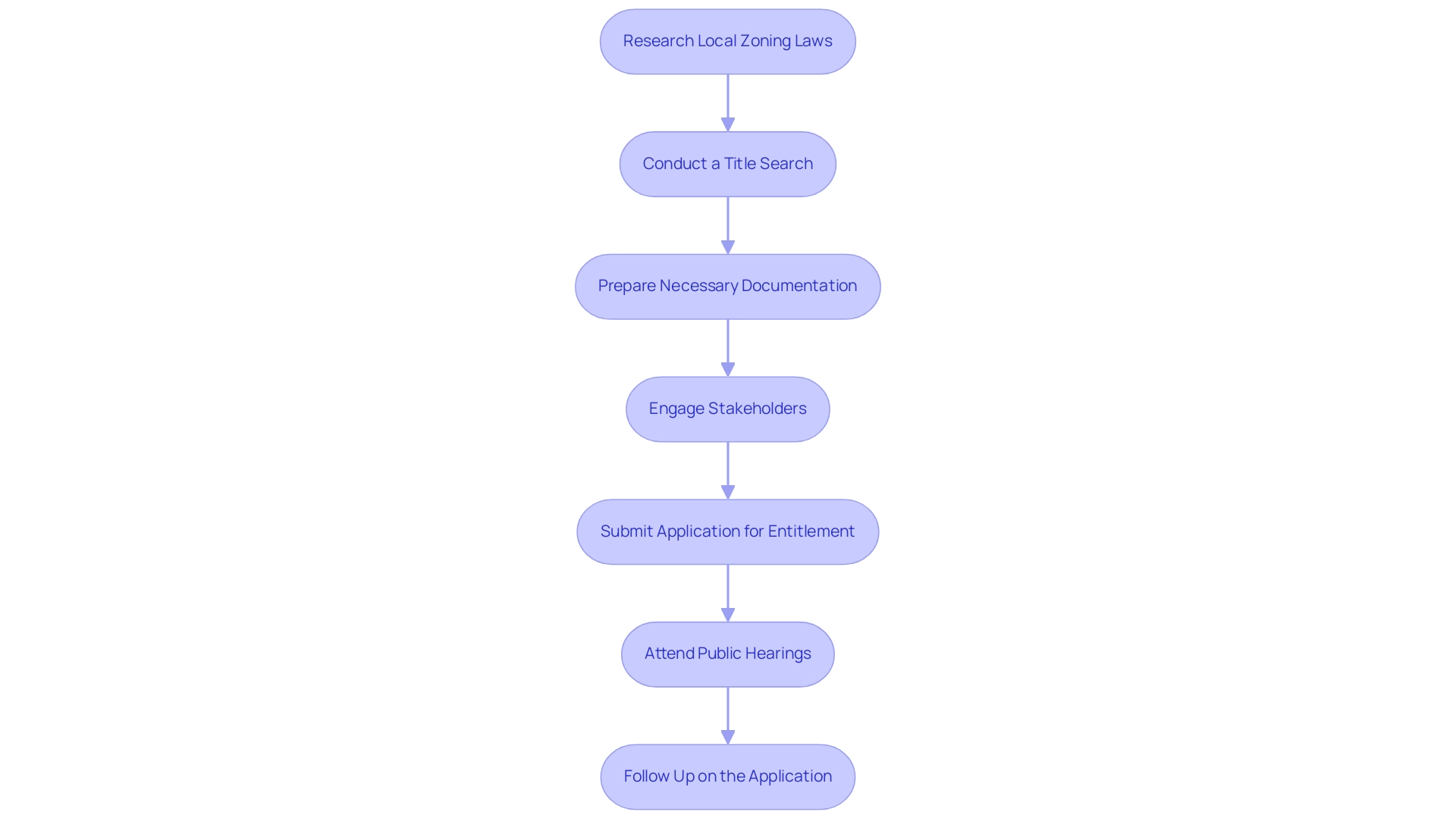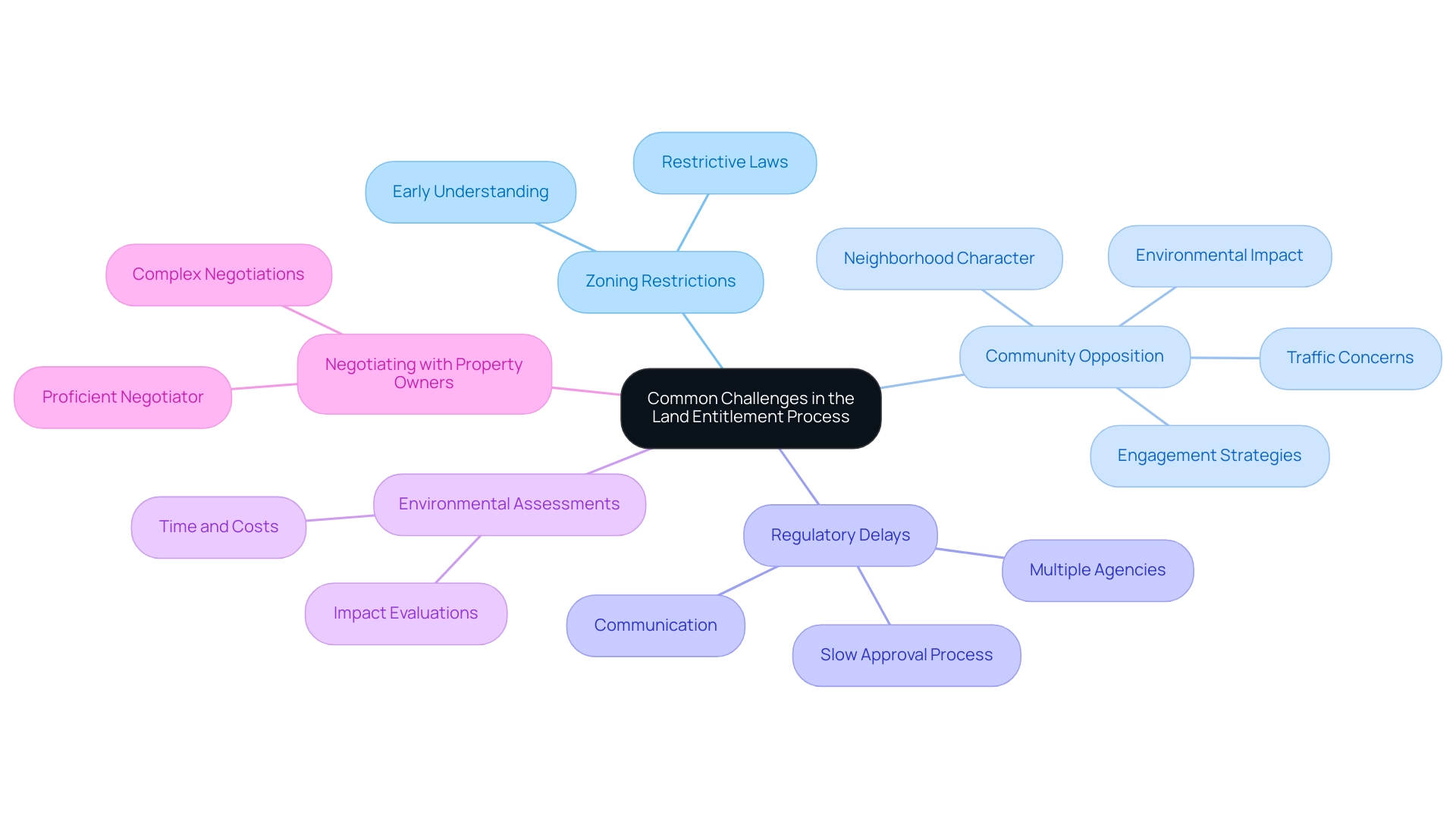Introduction
Navigating the complexities of land entitlement is a critical aspect of successful property development, yet it remains an area fraught with challenges and potential pitfalls. Understanding the legal framework that governs land use is essential for developers seeking to transform raw land into viable projects. From ensuring compliance with local zoning laws to engaging with community stakeholders, the entitlement process serves as the foundation upon which development initiatives are built.
As the demand for land continues to rise, so too does the need for a comprehensive grasp of the steps involved in securing the necessary rights and approvals. This article explores the intricacies of land entitlement, offering a step-by-step guide, identifying common challenges, and outlining best practices to ensure a smooth and successful process.
Understanding Land Entitlement: Definition and Importance
Property rights are the legal structure through which developers acquire the necessary permissions to use a specific plot for designated purposes, such as construction or development projects. This procedure is indispensable as it guarantees adherence to local zoning laws, environmental regulations, and other pertinent legal stipulations.
A comprehensive grasp of property rights is essential, as errors in this domain can result in considerable delays and higher expenses, ultimately threatening the overall viability of development projects. In 2024, statistics suggest that around 30% of land approval procedures in the US experience delays because of inadequate community involvement strategies.
Successful navigation of the approval system not only assists developers in evading legal issues but also encourages conformity with community standards and regulations. As stated, 'Effective community engagement requires reaching out to the right people at the right time.'
For instance, successful projects like the redevelopment of the former industrial site in Springfield exemplify how prioritizing direct engagement with affected residents fosters trust and facilitates broader community dialogue. This approach not only streamlines the entitlement process but also enhances project execution, ensuring that developers meet both regulatory requirements and community expectations.
Step-by-Step Guide to Initiating the Land Entitlement Process
- Research Local Zoning Laws: Begin by understanding the zoning regulations in your area. This includes identifying the zoning classification of the property and any restrictions that may apply. Consult local planning departments or zoning boards for detailed information.
- Conduct a Title Search: Utilize AI-powered title research software to ensure that the land has a clear title. This step is critical to identify any liens, encumbrances, or legal issues that could affect your entitlement process.
- Prepare Necessary Documentation: Gather all required documents, including site plans, environmental assessments, and any other materials needed for submission to regional authorities. Ensure that all documents adhere to regional regulations.
- Engage Stakeholders: Identify and connect with key stakeholders, including community members, government officials, and potential investors. Building relationships early on can facilitate smoother negotiations later in the process.
- Submit Application for Entitlement: Once all documents are prepared and stakeholders are engaged, submit your application to the relevant agency. Be prepared for potential revisions based on feedback from reviewers.
- Attend Public Hearings: Be ready to present your project at public hearings, where community members and officials can provide input. Address any concerns raised during these meetings to build support for your project.
- Follow Up on the Application: After submission, maintain communication with local authorities to track the progress of your application. Be proactive in addressing any inquiries for extra details or changes.
By adhering to these steps, you can effectively commence the entitlement procedure, paving the way for successful development projects.

Common Challenges in the Land Entitlement Process
-
Zoning Restrictions: Zoning laws can often be restrictive, limiting the types of developments allowed on specific parcels of land. Understanding these restrictions early can save time and resources.
-
Community Opposition: Local communities may oppose new developments due to concerns about traffic, environmental impact, or changes to the neighborhood's character. Engaging with the community early and addressing their concerns can mitigate opposition.
-
Regulatory Delays: The approval process can be slow, especially if multiple agencies are involved. Staying organized and maintaining open lines of communication with regulatory bodies can help expedite approvals.
-
Environmental Assessments: Depending on the location, environmental assessments may be required to evaluate potential impacts on local ecosystems. Be prepared for additional time and costs associated with these assessments.
-
Negotiating with Property Owners: If the area is not owned by the developer, negotiations can become complex. Having a proficient negotiator on your team can enable more seamless transactions and agreements.
By understanding these challenges, developers can enhance their preparedness and apply strategies to maneuver the property approval journey successfully.

Best Practices for a Successful Land Entitlement Process
- Start Early: Begin the land entitlement procedure as early as possible to accommodate any unforeseen delays. This proactive approach can keep your project on schedule.
- Build Relationships: Foster positive relationships with local officials, community members, and stakeholders. Open communication can lead to a more favorable reception of your project.
- Be Transparent: Provide clear and honest information throughout the journey to build trust with stakeholders. Transparency can help alleviate concerns and foster collaboration.
- Utilize Technology: Leverage technology such as GIS mapping and project management software to enhance efficiency. These tools can enhance coordination and improve accuracy in documentation.
- Stay Informed: Keep abreast of changes in regional regulations and community needs. Being knowledgeable enables you to adjust your strategy as needed and remain compliant with changing requirements.
By following these best practices, developers can manage the property approval procedure more efficiently, ensuring a smoother path to project completion.
Finalizing the Land Entitlement Process
- Review Approval Conditions: Carefully review any conditions outlined in the approval documents. Ensure that your project plans align with these conditions to avoid future complications.
- Secure Necessary Permits: Obtain all required permits and licenses before commencing any development activities. This includes building permits, environmental permits, and any other local requirements.
- Communicate with Stakeholders: Keep all stakeholders informed throughout the finalization phase. Regular updates can help maintain support and address any last-minute concerns.
- Prepare for Implementation: Begin planning for the implementation phase of your project. This includes coordinating with contractors, scheduling timelines, and ensuring that all resources are in place.
- Document Everything: Maintain comprehensive records of all communications, approvals, and documents related to the property approval procedure. This documentation is invaluable for future reference and compliance audits.
By following these final steps, developers can effectively conclude the land entitlement process and proceed confidently into the development phase.
Conclusion
Successfully navigating the land entitlement process is paramount for developers aiming to transform raw land into thriving projects. By understanding the legal framework and local zoning laws, conducting thorough research, and engaging with community stakeholders, developers can lay a strong foundation for their initiatives. Each step, from the initial title search to preparing necessary documentation and attending public hearings, plays a critical role in ensuring compliance and gaining community support.
However, challenges such as zoning restrictions, community opposition, and regulatory delays can impede progress. Awareness of these potential hurdles allows developers to implement proactive strategies, including early engagement with stakeholders and transparent communication. By employing best practices, such as leveraging technology and staying informed about local regulations, developers can enhance their chances of a successful entitlement process.
In conclusion, the land entitlement process is not merely a bureaucratic hurdle; it is an essential phase that dictates the viability of property development projects. By approaching this process with diligence, foresight, and a commitment to community collaboration, developers can not only mitigate risks but also foster positive relationships that contribute to the long-term success of their projects. As the demand for land continues to grow, mastering the intricacies of land entitlement will remain a vital skill for developers in an increasingly competitive landscape.
Frequently Asked Questions
What are property rights in the context of development projects?
Property rights are the legal permissions that developers need to use a specific plot of land for designated purposes, such as construction or development, ensuring compliance with local zoning laws and environmental regulations.
Why is understanding property rights important for developers?
A comprehensive understanding of property rights is crucial because mistakes in this area can lead to significant delays and increased costs, potentially jeopardizing the viability of development projects.
What percentage of land approval procedures in the US experience delays due to inadequate community involvement?
In 2024, statistics indicate that approximately 30% of land approval procedures in the US face delays because of insufficient community engagement strategies.
How can successful navigation of the approval system benefit developers?
Effectively navigating the approval system helps developers avoid legal issues and ensures compliance with community standards and regulations, fostering trust and facilitating dialogue with the community.
What are the first steps developers should take in the land entitlement process?
Developers should begin by researching local zoning laws, conducting a title search, preparing necessary documentation, engaging stakeholders, submitting an application for entitlement, attending public hearings, and following up on the application.
What challenges might developers face during the property approval process?
Developers may encounter challenges such as zoning restrictions, community opposition, regulatory delays, the need for environmental assessments, and negotiating with property owners.
What best practices can developers follow to manage the property approval procedure effectively?
Developers can start early, build relationships with stakeholders, be transparent, utilize technology, and stay informed about changes in regulations and community needs.
What final steps should developers take after receiving approval for their project?
After receiving approval, developers should review approval conditions, secure necessary permits, communicate with stakeholders, prepare for implementation, and document all aspects of the property approval process.
List of Sources
- Understanding Land Entitlement: Definition and Importance
- All Case Studies | ULI Case Studies (https://casestudies.uli.org/all-case-studies)
- The Role of Community Input in Land Entitlement for Higher Density Projects — The Cauble Group (https://tylercauble.com/blog/communityinputlandentitlement)




